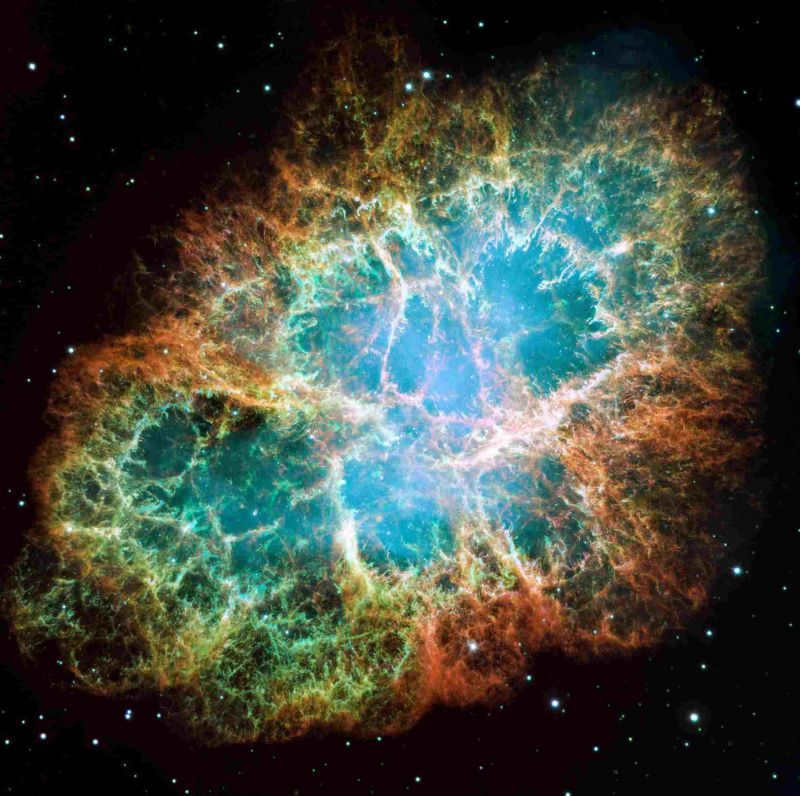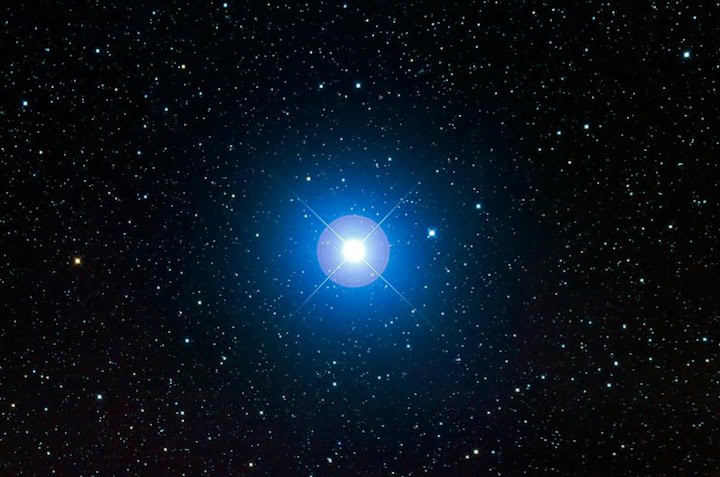- Blue giants, also known as O or B class stars, are youthful and hot massive stars that fall into the main sequence region of the Hertzsprung-Russell diagram. They have a stellar mass ranging from 10-20 times that of our sun, and their luminosity is thousands and even tens of thousands of times higher.
Similar ideas
A yellow supergiant refers to a supergiant star that falls under the spectral classes F or G. These stars typically have a mass of 15-20 times that of the Sun.
Hypergiants, on the other hand, are stars with massive size and mass, classified as luminosity class 0 on the Hertzsprung-Russell diagram. They are known to be the most powerful, heaviest, brightest, and also the rarest and shortest-lived supergiants. Hypergiants are generally considered to be supergiants with a brightness greater than -8m. KY Swan is an example of a star that falls on the border between hypergiant and non-hypergiant classifications; a star with lower luminosity would not be classified as a hypergiant.
Subdwarfs, previously known as sd (e.g., sdM5e) stars, belong to the VI luminosity class in the Yerkes classification system. These stars have luminosities that are 1.5-2 magnitudes fainter than main-sequence stars of the same spectral class. In the Hertzsprung-Russell diagram, subdwarfs are situated below the main sequence.
Flaring stars, also known as UV Kita-type stars, are variable stars that undergo sharp and non-periodic increases in their luminosity across the entire electromagnetic spectrum, from radio waves to X-rays.
References in literature
The length of time a star spends on the main sequence is determined by its initial mass. If the mass is large, the star’s radiation is incredibly powerful, and it quickly depletes its hydrogen “fuel” reserves. For instance, main-sequence stars with masses tens of times greater than that of the Sun (these are hot blue giants of spectral class O) can steadily emit radiation while on this sequence for only a few million years, whereas stars with masses similar to that of the Sun remain on the main sequence for 10-15 billion years. Table 2 below presents the calculated duration of gravitational contraction and main-sequence residence time for stars of various spectral classes. The same table provides the masses, radii, and luminosities of stars in terms of solar units.
A red supergiant is a massive and extremely large star that falls into the spectral class K or M and the luminosity class I. Prominent examples of red supergiants include Antares and Betelgeuse.
This list provides information on the brightest stars visible from Earth in the optical range, based on their apparent stellar magnitude. In the case of multiple stars, the total stellar magnitude is provided.
Polars, also known as AM Hercules-type variables or AM Her, are a specific type of cataclysmic variable found in double star systems with intense magnetic fields. These binary systems consist of a dwarf star belonging to the spectral class dK-dM and a hot, compact object with a strong magnetic field (M). Typically, there is a gloss change of about 1m in amplitude, but the average gloss can increase by 3m when the primary component is exposed to X-rays. The overall amplitude of light change can be significant.
Naugol (also known as Norma in Latin) is a constellation located in the southern hemisphere of the sky. It can be found to the southwest of Scorpius and to the north of the Southern Triangle, with Circulus touching its borders. While both branches of the Milky Way pass through this constellation, it is relatively lacking in bright stars. In fact, there are no stars in Naugol that shine brighter than 4.0 visual sidereal magnitude. Nevertheless, there are still 42 stars that are visible to the naked eye within its boundaries, occupying a sky area of 165.3 square degrees. The best conditions for observing this constellation are during the months of May and June. It is worth noting that Naugol can only be partially observed in southern Russia, specifically south of 48 N.
This is a compilation of the closest stars to Earth, arranged in order of increasing distance. The list encompasses stars that are within 5 parsecs (which is equivalent to 16.308 light-years) from our planet. In total, there are currently 57 known stellar systems, including our very own Sun, that may exist within this proximity. These systems collectively consist of 64 stars and 13 brown dwarfs.
Herbig stars, also known as Ae/Be stars, are young stars that have not yet reached the main-sequence stage. They belong to the spectral class A or B and are typically up to 10 million years old. These stars have a mass ranging from 2 to 8 times that of the Sun. Herbig stars are commonly found in star-forming regions and are surrounded by gas-dust clouds. They have surface temperatures ranging from 3500 to 6000 K. The spectra of these stars are characterized by strong emission lines, with the majority of the lines belonging to the Balmer series of hydrogen and ionized calcium. The given stars exhibit these unique characteristics.
Bright giants are a type of star that falls between giants and supergiants in terms of size and luminosity. While they have luminosities comparable to supergiants, they are generally not massive enough to be classified as supergiants. The masses of bright giants are typically within a few solar masses.
A double star system is referred to as a spectral double when the duality is identified through spectral observations. Typically, these systems involve components with significant velocities and close proximity, making it impossible to distinguish them individually with modern telescopes. Due to the orbital motion of stars around the center of mass, one star approaches us while the other moves away, resulting in unequal radial velocities in the direction of the observer.
The constellation Sagitta (Sge), also known as the Arrow, can be found in the northern hemisphere of the sky. It covers an area of 79.9 square degrees and contains 28 stars that are visible to the naked eye. One of these stars, Alpha Arrow (α Sge), is a double star.
Vulpecula (Vul), or the Foxglove, is a faint constellation in the northern hemisphere that is part of the Summer Triangle.
Dragon type variables are a type of main-sequence variable stars that belong to the late spectral classes, typically K or M. The BY of the Dragon is considered the prototype of this group of stars. The changes in their brightness are caused by their rotation, as they have large sunspots on their surface that are similar to sunspots but cover a much larger area. Additionally, their chromospheric activity also contributes to the variations in luminosity. The magnitude of the brightness fluctuations is usually less than 0.5 stellar magnitudes, and the duration of the cycles is equal to the star’s rotation period (from Wikipedia).
A shell star, also known as a star with an extended envelope, is characterized by a gas disk surrounding its equator, as indicated by its spectrum. The exact nature of these envelopes is still not fully understood, although their partial explanation lies in the star’s rapid rotation. Shell stars can have spectral classes ranging from O7.5 to F5, but their spectra exhibit extremely broad absorption lines due to the presence of the disk and the star’s fast rotation. The rotation speed at the equator can reach 200-250 km/s, which is close to the speed at which the star’s rotation reaches its peak.
In the realm of astronomy, the constellation Auriga, known as the Ascendant in Latin, can be found in the northern hemisphere of the sky. The brightest star in this constellation is Capella, with a visual sidereal magnitude of 0.1. The best conditions for observing this constellation are in the months of December and January, and it is visible throughout Russia.
Wolf-Rayet stars are a unique type of stars known for their exceptionally high temperature and brightness. These stars stand out from other hot stars due to the presence of broad hydrogen, helium, oxygen, carbon, and nitrogen bands in their spectra, which indicate varying degrees of ionization (N – N, C – C, O – O). The classification of these stars is named after the French astronomers Charles Wolf and Georges Rayet, who initially identified these distinctive features in their spectra back in 1867.
Luminous blue variables (LBV), also referred to as S Doradus variables (SDOR), are extremely bright blue pulsating hypergiants that derive their name from the star S Dor in the Large Magellanic Cloud. These stars exhibit irregular (occasionally cyclic) fluctuations in brightness, with amplitudes ranging from 1m to 7m. They typically represent the most brilliant blue stars in the galaxies where they are observed. Generally, they are accompanied by diffuse nebulae that envelop them.
The galactic halo (also known as the stellar halo) constitutes an imperceptible constituent of a galaxy, forming the primary component of its spherical subsystem. The halo possesses a spherical configuration and extends beyond the visible region of the galaxy. It mainly comprises of rarefied hot gas, stars, and dark matter, which collectively constitute the majority of the galaxy’s mass.
Slow irregular variables are a type of variable stars that do not exhibit any regular pattern in their changes in brightness, or if they do, it is only weakly expressed and occurs infrequently. The classification of these stars as slow irregular variables is often based on limited research and may change as more information becomes available. Some of these stars may actually be classified as semi-regular variables or belong to other types of variable stars.
The Hertzsprung-Russell diagram, also known as the Hertzsprung-Ressell diagram, Russell diagram, G-R diagram, or color-stellar magnitude, spectrum-luminosity diagram, illustrates the relationship between a star’s absolute magnitude, luminosity, spectral class, and surface temperature. Different regions on this diagram represent distinct groups of stars.
Supergiants are among the most massive stars. They are located in the upper part of the Hertzsprung-Russell diagram. In the Yerkes classification, supergiants correspond to classes Ia (bright supergiants) and Ib (less bright supergiants). Typically, the total (bolometric) absolute stellar magnitude of a supergiant falls between -5m and -12m. Supergiants that are exceptionally bright, with a magnitude brighter than -8m, are often classified as hypergiants.
Irregular variable stars are a type of variable stars that exhibit brightness variations according to a non-periodic pattern. There are two main types of irregular variables: eruptive and pulsating.
Fly (Latin: Musca, Mus) is a constellation in the Southern Hemisphere of the sky, situated in the Milky Way south of the Southern Cross constellation. It covers an area of 138.4 square degrees in the sky and contains 60 stars that can be seen with the naked eye.
The constellation Volans, also known as Flying Fish, can be found in the southern hemisphere of the sky. Covering an area of 141.4 square degrees, it contains 31 stars that are visible to the naked eye. However, it is not observable in Russia.
Infrared excess is a measured parameter used to determine the infrared flux of an astronomical source. It compares the measured flux to what would be expected based on the source’s spectral energy distribution, assuming it radiates as a black body. The spectral energy distribution of the white dwarf G29-38 is displayed on the left. In the longer wavelengths beyond 2 microns, the detected radiation is stronger than what would be expected from the visible spectrum alone, indicating an excess of infrared radiation.
Pheonix (Latin: Phoenix, Phe) is a constellation situated in the southern part of the sky. It occupies a vast area of 469.3 square degrees in the celestial sphere and contains a total of 68 stars that are visible to the naked eye.
Eclipsed stars (also referred to as eclipsed interlaced stars, eclipsed doubles, or photometric doubles) are stellar systems in which there is a periodic fluctuation in brightness due to the eclipses of one star by another.
A giant star is a specific type of star that possesses a significantly larger radius and higher luminosity compared to main-sequence stars with the same surface temperature. Typically, giant stars have radii ranging from 10 to 100 times that of the Sun and luminosities ranging from 10 to 1000 times that of the Sun. Stars with luminosities exceeding those of giant stars are classified as supergiants and hypergiants. Hot and brilliantly shining main-sequence stars can also be classified as white giants. Furthermore, due to their large radius and high luminosity, giants have distinct characteristics and properties.
The thin disk is a vital part of the composition of certain galaxies. In the case of the Milky Way, it is estimated that the thin disk spans up to 350 pc (1100 sv years) vertically and holds approximately 85% of the stars within the galactic plane. The thin disk can be distinguished from the thick disk due to its population, which consists mainly of younger stars formed during later stages of the galaxy’s development. Conversely, the thick disk is predominantly comprised of older stars that originated earlier in the galaxy’s evolution. The stars within the thin disk are believed to have formed through the accumulation of gas during subsequent phases of the galaxy’s formation.
Korma (Latin: Puppis, Pup) is a constellation located in the southern hemisphere of the celestial sphere and is situated within the Milky Way. Covering an impressive 673.4 square degrees, it boasts a total of 241 stars that can be observed without the aid of a telescope. The visibility of Korma varies depending on the observer’s location, with the southernmost regions having the best view of the constellation. The brightest star in Korma, ζ Korma, becomes visible at a latitude of 50°. In Adler, this star rises at approximately 6°30', while in the south of Dagestan, it rises at around 8°30'. In the cities located at the southernmost points of observation, the visibility of Korma is even more pronounced.
Sails (also known as Parus) (Latin: Vela) is another constellation found in the southern hemisphere of the night sky. Its southern boundary runs alongside the most densely populated regions of the Milky Way. Covering a vast expanse of 499.6 square degrees, Sails consists of 195 stars that can be seen without the use of a telescope.
The nebula known as the Orion Cloud is a collection of interstellar matter located in the constellation Orion within the Milky Way galaxy. It is situated approximately 1600 light-years away from the Sun and spans dimensions of several hundred light-years.
The constellation Columba, also referred to by its Latin name Columba, abbreviated as Col, is found in the southern hemisphere of the celestial sphere. It covers an area of 270.2 square degrees and boasts 71 stars that can be seen without the aid of a telescope. Observers in the southern regions of Russia can view the entirety of this constellation during the months of December and January. The brightest star in Columba is known as Fact.
Dorado, derived from the Latin word Doradus, is the name of a constellation located in the southern celestial hemisphere. It occupies an area of 179.2 square degrees and showcases 32 stars that are visible to the unaided eye.
Interstellar dust is comprised of tiny solid particles that fill the space between stars, along with interstellar gas. Scientists currently believe that these particles have a core made of refractory material, which is then surrounded by either organic matter or an icy shell. The composition of the core is determined by the atmosphere of the stars in which the particles condensed. For instance, if they condensed in the atmosphere of a carbon star, the core would be made of graphite and silicon carbide.
Clock, also known by its Latin name Horologium (Hor), is a constellation located in the southern hemisphere of the sky. It can be found to the southeast of southern Eridanus. Clock covers an area of 248.9 square degrees in the sky and contains 35 stars that can be seen without the aid of a telescope.
Cepheus (Latin: Cepheus) is a constellation in the heavens of the Northern Hemisphere, taking on the form of an irregular pentagon. The southern portion of this constellation is situated within the Milky Way. It covers an expanse of 587.8 square degrees in the sky and is home to 148 stars that can be seen with the naked eye.
Zajac (Latin: Lepus) is a constellation found in the southern skies. It covers an area of 290.3 square degrees in the heavens and is home to 72 stars that can be seen without the aid of a telescope. This constellation is observed in the central and southern regions of Russia, with the most favorable viewing conditions occurring in the month of December.
Pictor is a compact group of stars located in the southern hemisphere of the celestial sphere. It covers a region spanning 247.7 square degrees and boasts a collection of 49 stars that can be seen with the naked eye. In the southern regions of Russia, specifically south of latitude +47°, a portion of Pictor can be observed, albeit without any prominent stars. The constellation’s first relatively luminous star, β Zhivopisets, with a magnitude of 3.85, rises south of latitude +38°56′ (making it visible in locations such as Dushanbe, Astara, Ashgabat, and Kushka within the former USSR). Additionally, there is a star within the constellation known as Zhivopisitsa.
There are three categories of stars that share similarities with the Sun: solar-type stars, star analogs of the Sun, and Sun doubles. The study of these stars is crucial for gaining a better understanding of the Sun’s properties, determining its uniqueness or typicality among other stars, and exploring the potential existence of habitable planets in other solar-type stars.
Tucan, also known as Tucana or Tuc, is a constellation located in the southern hemisphere of the sky. It covers an area of 294.6 square degrees and contains 44 stars that can be seen with the naked eye.
Cepheids, which are named after the star δ Cepheus, are a type of pulsating variable stars that exhibit a reliable period-luminosity relationship. Among the well-known Cepheids, Polaris stands out. These stars serve as crucial reference points for astronomers due to their periodicity and brightness, making them invaluable for estimating distances to remote celestial objects.
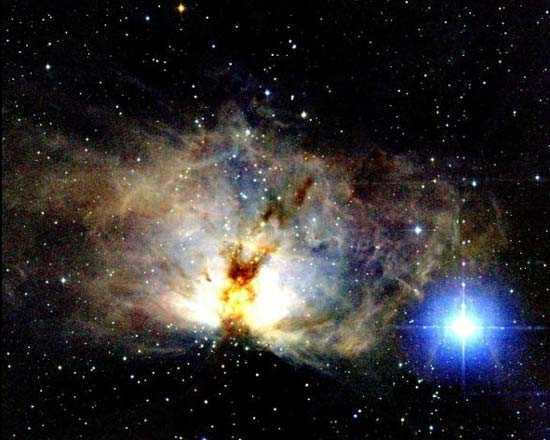
Stellar Objects
The celestial body with a blue hue is a member of the supergiant category, specifically falling within the O and B spectral classes. Distinguished by its relatively youthful age and scorching surface temperature ranging from 20 to 50 thousand degrees Celsius, these stars surpass the mass of our Sun by a factor of 10 to 15, with an average maximum radius parameter equivalent to 25 times that of our Sun.
General descriptive characteristics
Rare and enigmatic, these objects hold a multitude of mysteries. They shine with unparalleled brilliance and radiate intense heat, yet their existence is short-lived, spanning a mere 10-50 million years. Such celestial bodies are primarily found in youthful cosmic formations, concentrated in the following regions:
These supergiants are nearly absent in the nuclear cores of spiral galaxies and globular clusters, which are considered ancient. Despite their scarcity and ephemeral lifespans, these luminous giants often grace the night sky, visible to the naked eye. Their remarkable luminosity far outshines their limited numbers.
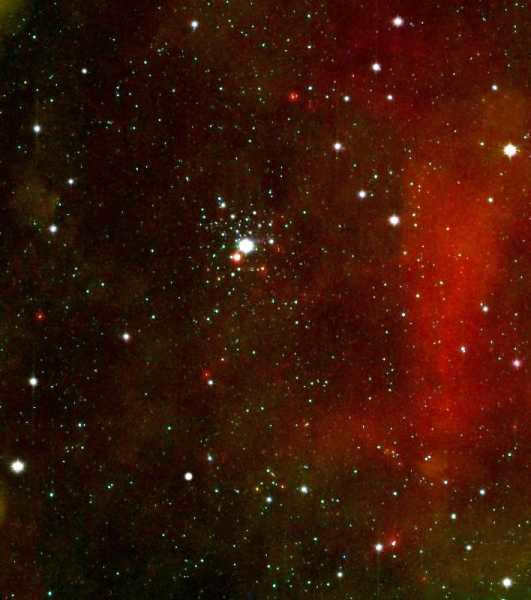
The Big Dog’s Tau star is located in the NGC 2362 star cluster and stands out due to its unique blue color.
Understanding the Formation of Blue Color
The color of a star is determined by its surface temperature, and blue stars are no exception. On the surface of the Sun, for example, the temperature is over 6000 degrees Kelvin. Although we see the Sun as a yellow object from Earth, it appears white when observed from outer space due to its high temperature. If the temperature were lower, the light emitted would be darker in color.
This hidden knowledge transformed into a crucial tool for astronomers: by studying the hues of celestial bodies, they could gather valuable data about surface temperatures. At the core of this phenomenon lies the relationship between the energy emitted by a substance and the color of light it produces.
The logical and just conclusion is this: the hotter an object is, the closer its color will be to blue. Conversely, the colder an object is, the more its hue will tend towards dark red. This holds true for blue stars as well. The impact of a star’s composition on its color is minimal, as temperature can obscure certain elements through the process of ionization.
The concept of “coloring”
When discussing the physical characteristics of a phenomenon like a blue supergiant, it is important to consider the role of temperature in determining its appearance. The temperature of the supergiant affects the speed of molecular movement within its body, which in turn impacts the wavelengths of light that can pass through it. Higher temperatures result in shorter wavelengths, while lower temperatures lead to longer wavelengths.
The hue exhibited by a celestial body assumes a significant function in multiple systems of its categorization. This factor alone is fundamental in the determination of a specific spectral category. As there is a direct correlation between hue and temperature, it is plotted on a specialized Hertzsprung-Russell diagram. This aids in the identification of the subsequent characteristics:
All of these aspects contribute to making this diagram an exceptionally valuable repository of insightful data regarding celestial bodies.
Mutual metamorphosis
A blue hypergiant is a colossal entity situated in a specific stage of the “dying” procedure. During this phase, the magnitude of the events taking place in the nucleus is considerably diminished, leading to the contraction of the celestial body. Consequently, the emission of energy becomes denser, causing a substantial rise in temperature on the surface. These factors collectively trigger the conversion of a red hypergiant into a blue entity. Conversely, there exists the potential for a reciprocal reaction.
As the celestial body undergoes changes, it has the ability to undergo multiple transformations in various directions. This results in the creation of concentrically fragile layers. During the transitional stage, the entity may exhibit a yellow or white hue, similar to that of Polaris. Typically, these entities conclude their existence with the dramatic event of a supernova explosion. However, a few manage to continue their evolutionary journey, eventually becoming white-colored oxygen-neon dwarfs.
Well-Known and Common Instances
A blue star is a celestial body that commands special attention among scientists and casual observers alike. To gain an understanding of its fundamental characteristics, it is worthwhile to examine a few notable examples.
- Rigel. This is the most renowned entity situated within the confines of the Orion constellation.
- Gamma Sails. A multitude of blue supergiants that belong to the eponymous constellation.
- Alpha Giraffe. Its distance amounts to roughly 7000 light years.
- Orion’s Zeta. It belongs to the O class and is the brightest.
- Tau of the Big Dog. A spectral blue supergiant positioned 3200 light years away.
Thus, this cluster of stellar bodies generates immense interest among scientists.
Blue supergiants are incredibly large stars that have relatively short lifespans and tend to burn out quickly. These celestial objects pose a challenge for astronomers to study, even with the aid of the most advanced instruments available.
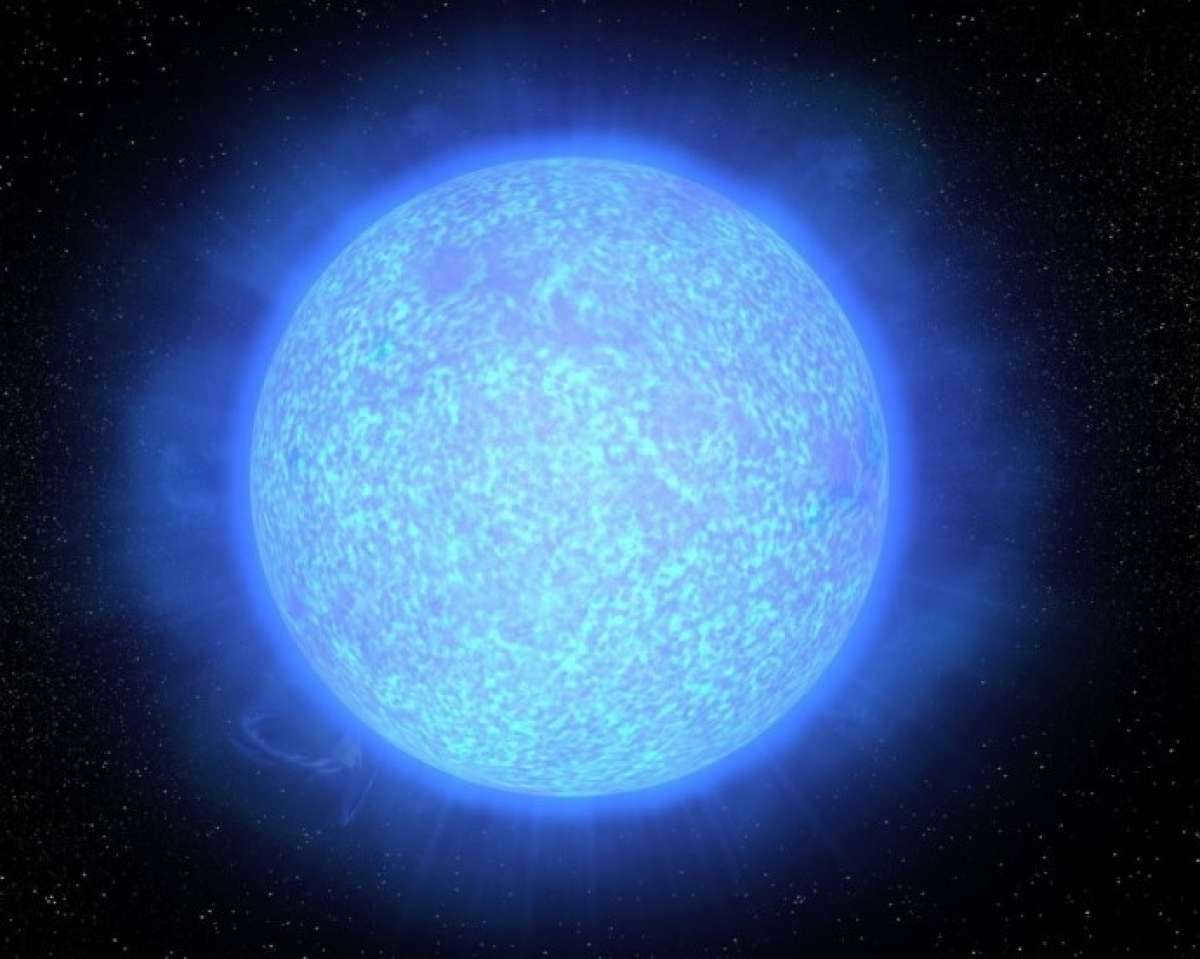
The emergence and classification of blue giant stars
Prior to the inclusion of space telescopes in the scientist’s toolkit, the existence of blue giants was known in limited quantities, thus mankind possesses only a modest understanding of these celestial bodies.
The birth of all stars follows a unified process. A vast molecular cloud undergoes compression due to the force of gravity, gradually forming a dense sphere until the conditions for nuclear fusion are met, triggered by internal temperatures. Throughout its lifespan, the colossal luminary is engaged in an internal battle; the outer surface is influenced by gravitational forces, while the core is impacted by the intense heat and pressure of matter, which strives to expand. With the gradual consumption of hydrogen and helium in the central region, these massive stars transform into supergiant stars.
The Yerkes classification, which categorizes stars based on their luminosity spectrum, is well-known. In this classification, supergiant stars are referred to as Class I and are further divided into the following groups:
In the Harvard classification, which categorizes stars based on their spectrum type, these luminous objects are classified from O to M. Blue giants are classified as O, B, A, while red stars are classified as K, M. Intermediate and poorly studied yellow stars are classified as F, G.
Intriguing information about blue supergiants
Blue supergiants are distinguished by their relatively young age and their incredibly high surface temperature, ranging from 20,000 to 50,000 degrees Celsius. These celestial bodies possess a mass 10 to 15 times greater than that of the Sun, with their maximum radius averaging around 25 times that of the Sun.
Blue supergiants are enigmatic entities that captivate scientists with their brilliance and intense heat. Due to their immense mass, they have a short lifespan of only 10 to 50 million years. These cosmic marvels can be found exclusively in youthful celestial formations, primarily including:
Because there is a clear correlation between the color and temperature of the supergiant, a unique Hertzsprung-Russell diagram was developed to showcase these important parameters:
As the star evolves, it may alter its color, transitioning to a yellow or white hue, similar to Polaris. However, conventionally, the existence of such a celestial body typically culminates in an explosive event.
Outstanding examples of blue supergiants
The blue supergiant star is an astronomical object that commands special attention among both astronomers and the general public. To gain an understanding of its fundamental characteristics, let’s examine a few actual instances:
- “Rigel” stands out as the most renowned celestial body situated in the Orion constellation;
- “Gamma Sails” – a multiple blue supergiant that belongs to the eponymous constellation;
- “Alpha Giraffe” – positioned roughly 7,000 light years away;
- “Orion’s Zeta” – the most brilliant supergiant of the O class;
- “Big Dog Tau” – a spectral blue supergiant star positioned at a distance of 3,200 light years.
The colossal blue luminaries of the cosmos never fail to evoke exceptional interest among astronomers.
A variety of stars are examined by astronomers. Certain stars have long lifespans and thrive, while others are created quickly. These stars have relatively short lives and experience a violent demise in just a few tens of millions of years. Blue supergiants belong to this latter group. They are found throughout the night sky. One example is the prominent star Rigel in the Orion constellation, and their clusters are located at the centers of expansive regions where stars are formed, such as the R136 cluster in the Large Magellanic Cloud.
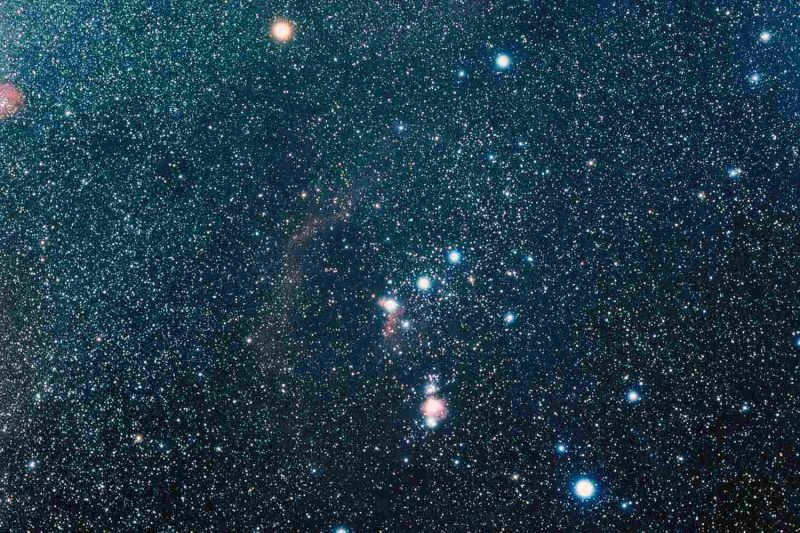
What is a blue supergiant star and what sets it apart?
A blue supergiant star is characterized by its massive size. These celestial giants can be compared to 800-pound gorillas in the star world. In fact, most blue supergiants are at least ten times more massive than our Sun, with some even surpassing that weighty threshold. The most colossal blue supergiants have the ability to generate the luminosity of 100 Suns or more.
Due to their immense mass, blue supergiant stars require a substantial amount of fuel to maintain their brilliance. Just like any other star, their primary nuclear fuel is hydrogen. However, once they exhaust their hydrogen reserves, they resort to burning helium in their cores. This process leads to a significant increase in temperature and luminosity, causing the star to expand in size. This expansion signifies the approaching end of the star’s life, and before long (in cosmic terms), a supernova explosion will take place.
An in-depth examination of “The Astrophysics of the Blue Supergiant.”
This article provides a brief overview of blue supergiants, but by delving deeper into the scientific understanding of these celestial objects, we can uncover a wealth of additional information. To truly comprehend blue supergiants, it is crucial to have a grasp of the fundamental physics that governs the behavior of stars. This field of study, known as astrophysics, reveals that stars spend the majority of their existence in a phase referred to as the “main sequence.” During this stage, stars undergo a nuclear fusion process called the proton-proton chain, converting hydrogen into helium within their cores. In addition, high-mass stars can utilize the carbon-nitrogen-oxygen (CNO) cycle to enhance and accelerate these reactions.
Nevertheless, once the hydrogen fuel is depleted, the star’s core undergoes a rapid collapse and intensifies in temperature. As a result, the star’s outer layers expand outward due to the heightened heat produced in the core. In the case of stars with low and intermediate masses, this sequence of events leads to their transformation into red giants, whereas high-mass stars evolve into red supergiants.
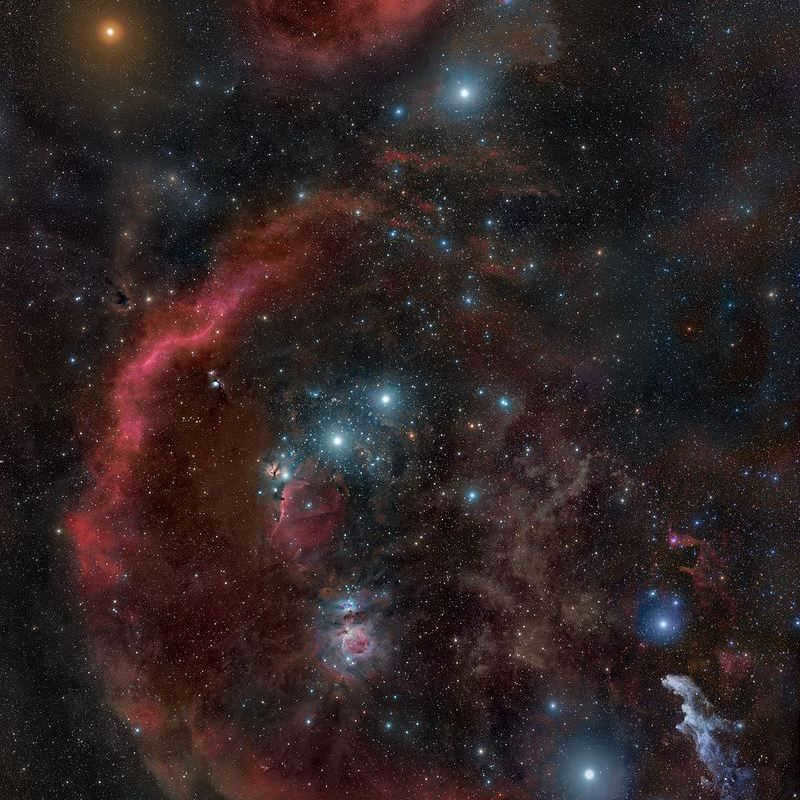
In stars with a high mass, the process of converting helium into carbon and oxygen occurs at an accelerated pace in the cores. The color of the star’s surface is red, which is a direct consequence of its low surface temperature, as indicated by Wien’s law. Although the core of the star is extremely hot, the energy is distributed throughout its interior as well as its vast surface area. Consequently, the average surface temperature ranges from 3,500 to 4,500 Kelvin…
As the star continues to fuse heavier elements in its core, the rate of fusion can vary significantly. At this stage, the star may undergo contraction during periods of sluggish fusion and subsequently transform into a blue supergiant. These stars often transition between the red and blue supergiant phases before ultimately culminating in a supernova.
Characteristics of blue supergiants
Despite red supergiants being the largest stars, with a radius 200 to 800 times that of our Sun, blue supergiants are noticeably smaller. Most have a radius of less than 25 solar radii. However, they are often recognized as some of the most massive objects in the universe. (It’s important to note that being massive does not always equate to being large. Some of the most massive entities in the universe, such as black holes, are actually very small.) Additionally, blue supergiants exhibit extremely fast and thin stellar winds that traverse through space.
The demise of blue supergiants
As previously mentioned, blue supergiants will ultimately meet their end through supernova explosions. When this occurs, their evolution may culminate in the formation of a neutron star (pulsar) or a black hole. These explosive events also result in the creation of stunning clouds of gas and dust known as supernova remnants. One of the most well-known examples of these remnants is the Crab Nebula, which was formed by the explosion of a star thousands of years ago. This celestial spectacle became visible on Earth in 1054 and continues to be observable through telescopes. Although the progenitor star of the Crab Nebula may not have been a blue supergiant, it serves as a poignant reminder of the fate that awaits such stars as they near the end of their lifespan.
